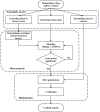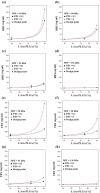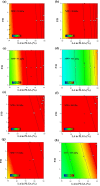A new evidence-based design-of-experiments approach for optimizing drug delivery systems with exemplification by emulsion-derived Vancomycin-loaded PLGA capsules
- PMID: 39732761
- PMCID: PMC11682087
- DOI: 10.1038/s41598-024-82496-3
A new evidence-based design-of-experiments approach for optimizing drug delivery systems with exemplification by emulsion-derived Vancomycin-loaded PLGA capsules
Abstract
This paper introduces an evidence-based, design-of-experiments (DoE) approach to analyze and optimize drug delivery systems, ensuring that release aligns with the therapeutic window of the medication. First, the effective factors and release data of the system are extracted from the literature and meta-analytically undergo regression modeling. Then, the interaction and correlation of the factors to each other and the release amount are quantitatively assessed. Finally, the factors are numerically and graphically optimized via linking the meta-analyzed release data and the well-documented therapeutic window of the drug, followed by verification. For a more in-depth explanation, the introduced approach is exemplified by a drug delivery, consisting of emulsion-derived poly lactic-co-glycolic acid-vancomycin (PLGA-VAN) capsules for treating Staphylococcus Aureus-induced osteomyelitis. Novel and validated findings for the model system, along with the thorough architecture of the introduced approach, suggest its potential applicability for any delivery systems with sufficient reliable data in the literature.
Keywords: Burst and sustained release kinetics; Local controlled drug delivery systems; Pharmacokinetics.
© 2024. The Author(s).
Conflict of interest statement
Declarations. Competing interests: The authors declare no competing interests.
Figures





Similar articles
-
Silk fibroin/chitosan thiourea hydrogel scaffold with vancomycin and quercetin-loaded PLGA nanoparticles for treating chronic MRSA osteomyelitis in rats.Int J Pharm. 2024 Dec 5;666:124826. doi: 10.1016/j.ijpharm.2024.124826. Epub 2024 Oct 12. Int J Pharm. 2024. PMID: 39401582
-
Osteogenic and antibacterial properties of vancomycin-laden mesoporous bioglass/PLGA composite scaffolds for bone regeneration in infected bone defects.Artif Cells Nanomed Biotechnol. 2018 Dec;46(8):1935-1947. doi: 10.1080/21691401.2017.1396997. Epub 2017 Nov 7. Artif Cells Nanomed Biotechnol. 2018. PMID: 29113502
-
Antibiotic-loaded plaster of Paris implants coated with poly lactide-co-glycolide as a controlled release delivery system for the treatment of bone infections.Int Orthop. 1997;21(6):403-8. doi: 10.1007/s002640050195. Int Orthop. 1997. PMID: 9498152 Free PMC article.
-
Phenomenology of the Initial Burst Release of Drugs from PLGA Microparticles.ACS Biomater Sci Eng. 2020 Nov 9;6(11):6053-6062. doi: 10.1021/acsbiomaterials.0c01228. Epub 2020 Oct 9. ACS Biomater Sci Eng. 2020. PMID: 33449671 Review.
-
PLGA-based biodegradable microspheres in drug delivery: recent advances in research and application.Drug Deliv. 2021 Dec;28(1):1397-1418. doi: 10.1080/10717544.2021.1938756. Drug Deliv. 2021. PMID: 34184949 Free PMC article. Review.
Cited by
-
Regulation and induction of fungal secondary metabolites: a comprehensive review.Arch Microbiol. 2025 Jul 1;207(8):189. doi: 10.1007/s00203-025-04386-0. Arch Microbiol. 2025. PMID: 40590991 Review.
References
-
- Joshi, D., Garg, T., Goyal, A. K. & Rath, G. Advanced drug delivery approaches against periodontitis. Drug Deliv. 23, 363–377. 10.3109/10717544.2014.935531 (2016). - PubMed
-
- Chen, Y. C., Gad, S. F., Chobisa, D., Li, Y. & Yeo, Y. Local drug delivery systems for inflammatory diseases: Status quo, challenges, and opportunities. J. Controlled Release. 330, 438–460. 10.1016/J.JCONREL.2020.12.025 (2021). - PubMed
-
- Derakhshandeh, K., Erfan, M. & Dadashzadeh, S. Encapsulation of 9-nitrocamptothecin, a novel anticancer drug, in biodegradable nanoparticles: factorial design, characterization and release kinetics. Eur. J. Pharm. Biopharm.66, 34–41. 10.1016/J.EJPB.2006.09.004 (2007). - PubMed
MeSH terms
Substances
LinkOut - more resources
Full Text Sources

